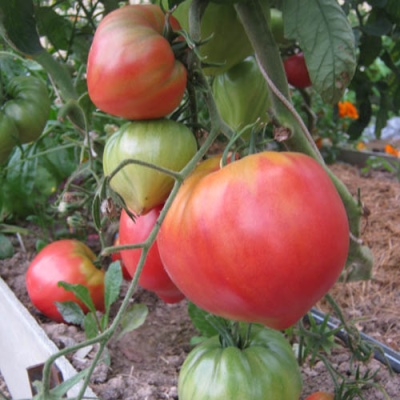
- Authors: Avdeev Yu.I., Kigashpaeva O.P., Ivanova L.M., Avdeev A.Yu.
- Year of approval: 2006
- Category: grade
- Growth type: determinant
- Appointment: fresh consumption, for whole fruit preservation
- Ripening period: mid-season
- Ripening time, days: 105-115
- Growing conditions: for open ground, for film greenhouses
- Marketability: high
- Bush height, cm: 60-70
Tomato Robin is a variety of pink tomatoes that are rightfully recognized as the sweetest. Gardeners value culture for attractive fruits and their unique taste.
Description of the variety
The robin was brought out by breeders from Russia, entered into the State Register and approved for use in 2006. The tomato belongs to the group of mid-season crops, suitable for growing both on open grounds and in greenhouse conditions. Variety characteristics:
bush height - up to 60 cm;
bush type - determinant;
inflorescences - simple or intermediate type;
the number of sheets is average.
The Robin tomato has small leaves of a rich green color.
The main qualities of the fruit
The culture is characterized by small fruits, the mass of which lies in the range from 50 to 70 g. The shape is identical to plum, oval-cylindrical. Each fruit has 2-3 nests. The surface is covered with a smooth skin that shines in the sun and has a raspberry or pink tint. The pulp is slightly darker, contains a large amount of juice.
Taste characteristics
The robin fruit is juicy. The dense pulp gives a pleasant taste. Tomatoes are eaten fresh, and also used for cooking:
salads;
mashed potatoes;
sauces.
And also the fruits are suitable for canning.
Ripening and fruiting
The tomato belongs to the mid-season varieties. From the moment of sowing the seeds to the full ripening of the fruits, it takes 105-120 days.
Yield
One square meter of a bush is capable of producing up to 5-8 kg of fruit.
The timing of planting seedlings and planting in the ground
Before sowing, it is necessary to prepare the material. To do this, tomato seeds will need to be soaked in a solution of water and potassium permanganate in an amount of 1 liter and 1 g, respectively. The seeds should be in the solution for 15 minutes, after which the empty ones will float to the top, and the good ones will remain at the bottom.
Once the seeds have been prepared, they will need to be sown in pre-prepared containers, pots, or plastic cups. To obtain a fertile mixture, it will be necessary to combine:
garden land;
humus;
wood ash;
sand.
The sowing depth of the seeds should not exceed 1 cm. After planting, the soil must be sprinkled with peat, and then moistened with a spray bottle. At the end, it remains to cover the containers with polyethylene and rearrange them to a warm place. When the first shoots appear, the “cover” can be removed, and the containers can be installed on the windowsill, where the sun's rays will contribute to the growth of seedlings.

Growing tomato seedlings is an extremely important process, because it largely depends on whether the gardener can harvest at all. All aspects must be taken into account, from seedbed preparation to planting in the ground.
Landing scheme
Before planting seedlings in the soil, it is necessary to harden it. This will require a number of steps.
On the first day, leave the seedlings outside for 3 hours.
On the second day, increase the time interval to 5 hours, and repeat the procedure.
On the third day, take out the tomatoes for 8 hours.
For planting Robins, it is better to choose well-lit areas with low acidity soil. The best time for gardening is May or early June. To plant tomatoes, you need to do the following.
Mark the site, and make holes up to 20 cm deep.
Leave a row spacing of 0.5 m.
Leave a distance of 0.4 m between the bushes.
Pour 50-100 g of wood ash and 0.4 kg of humus into the holes.
Pour in 2 liters of warm water.
Plant the seedlings when moisture is absorbed into the soil.
At the end, it remains to fill the holes with soil, and pour warm water again.

Growing and caring
To get a good harvest, you need to take care of the Robin. Care Tips:
use warm water for irrigation;
watering young bushes, using 1-2 liters of water at a time for young bushes and 5 liters for grown and stronger plants;
fertilize the soil before flowering with a solution of 10 liters of water, 0.2 kg of humus and 0.3 kg of wood ash;
a week before the formation of fruits, feed the plant with a mixture of 0.4 g of ammonium nitrate and 5 liters of water;
a week after the end of the fruit formation by the bush, add 30 g of superphosphate dissolved in 5 liters of water to the soil.
And also gardeners are advised to remove the lower leaves, and not allow the variety to grow more than 2 stems.




A plant needs different micronutrients at each stage of growth. All fertilizers can be divided into two groups: mineral and organic. Folk remedies are often used: iodine, yeast, bird droppings, eggshells.
It is important to observe the rate and period of feeding. This also applies to folk remedies and organic fertilizers.
Disease and pest resistance
The Robin tomato is resistant to various pests and diseases. The variety does not react in any way to tobacco mosaic and top rot, which most crops in this family are susceptible to. If a bush is affected by a fungus, you can use fungicides, or ventilate the greenhouse if the tomatoes grow in an enclosed space.
Frequent guests of the plant:
insects;
aphid;
slugs;
Colorado beetles.
Insects and aphids can be treated with insecticides and soap solutions. The last two pests are best hand picked. It is recommended to carry out procedures when using chemicals before flowering.



























































































